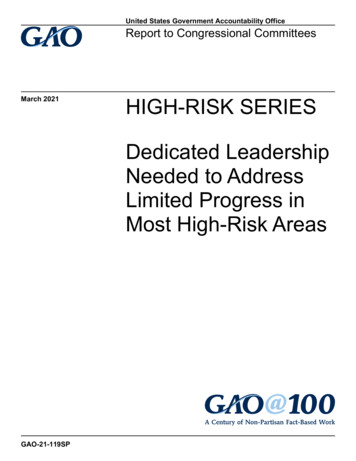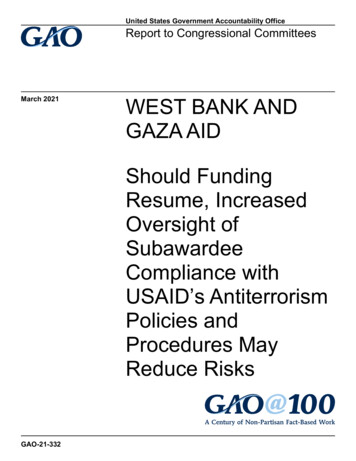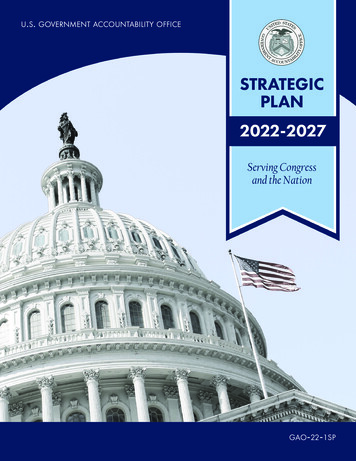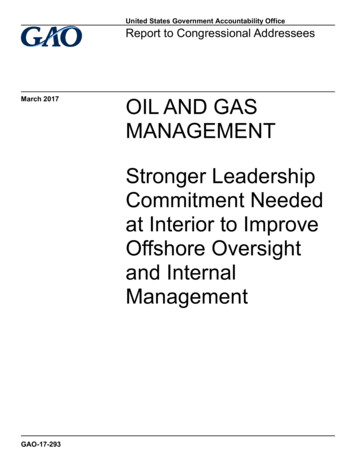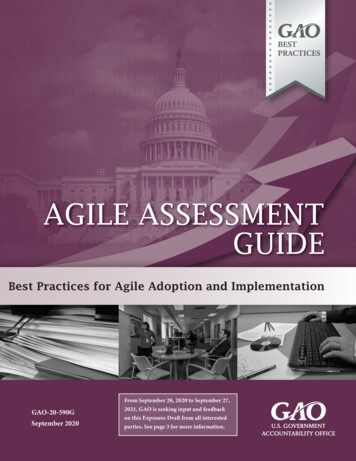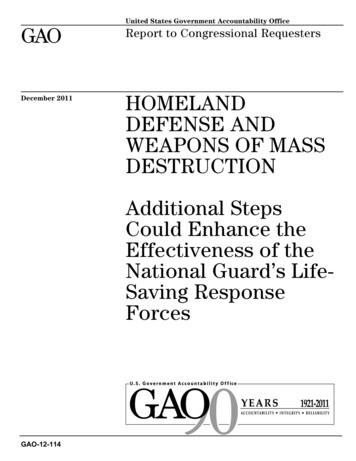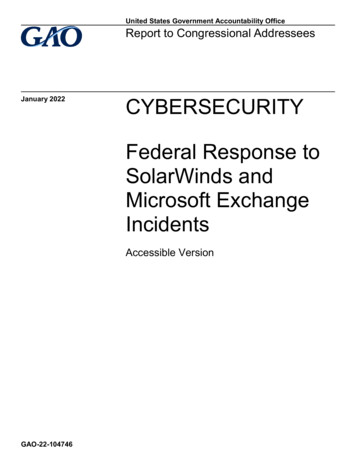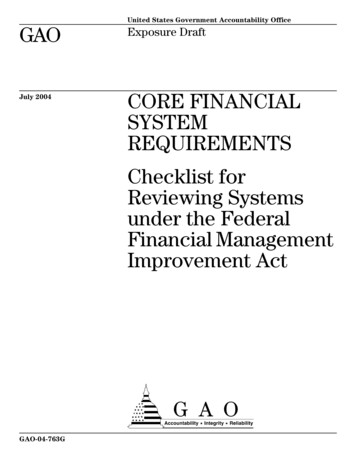
Transcription
United States Government Accountability OfficeGAOExposure DraftJuly 2004CORE FINANCIALSYSTEMREQUIREMENTSChecklist forReviewing Systemsunder the FederalFinancial ManagementImprovement ActGAO-04-763Ga
PREFACEJuly 2004The Federal Financial Management Improvement Act of 1996 (FFMIA) requires, amongother things, that agencies implement and maintain financial management systems thatsubstantially comply with federal financial management system requirements. Theserequirements are detailed in the Federal Financial Management System Requirementsseries issued by the Joint Financial Management Improvement Program (JFMIP) and inthe guidance issued by the Office of Management and Budget (OMB): Circular A-127,Financial Management Systems, and the January 4, 2001, Revised ImplementationGuidance for the Federal Financial Management Improvement Act (FFMIA) of 1996.JFMIP intends for the requirements to promote understanding of key financialmanagement systems concepts and requirements, to provide a framework forestablishing integrated financial management systems to support program and financialmanagers, and to describe specific requirements of financial management systems.We are issuing this checklist, which reflects JFMIP’s revised Core Financial SystemRequirements (JFMIP-SR-02-01, November 2001), to assist (1) financial systems analysts,systems accountants, systems developers, program managers, and others who design,develop, implement, operate, or maintain financial management systems and(2) management and auditors in reviewing agency core systems to determine if thesystems substantially comply with FFMIA.There is no requirement that this checklist be used in assessing core financial systems.Rather, it is provided as a tool for use by experienced staff and is one in a series ofdocuments we have issued to assist agencies in improving or maintaining effectiveoperations. (See the last page of this document for a list of related products.) Thischecklist, the JFMIP source document, and the two previously mentioned OMBdocuments should be used concurrently. Those using this tool must apply experiencedjudgment in its interpretation and application. They must consider the impact of thecompleted checklist on an entire core system and whether the system, as a whole,substantially complies with requirements.This checklist exposure draft is available on the GAO Web site (http://www.gao.gov)under “Reports and Testimony,” browsing by the topic “Financial Management.” JFMIP’ssource document can be downloaded from the JFMIP Web site (http://www.jfmip.gov)under “JFMIP Documents” and the subheading “System Requirements.”Please send comments on this exposure draft by August 31, 2004, to McCoy Williams,Director, Financial Management and Assurance, U.S. Government Accountability Office,441 G Street, N.W., Room 5089, Washington, D.C. 20548.Jeffrey C. SteinhoffManaging DirectorFinancial Management and Assurance
(BLANK)
CONTENTSPagePreface. 1Overview . 6Authoritative Guidance. 7How to Use This Checklist . 8Core Financial System Requirements . 10Functional Requirements . 13Core Financial System Management Function. 13Accounting Classification Management Process . 13Transaction Control Process . 19General Ledger Management Function . 28General Ledger Account Definition Process . 28Accruals, Closing, and Consolidation Process . 30General Ledger Analysis and Reconciliation Process . 32Funds Management Function . 33Budget Preparation Process . 33Budget Formulation Process . 35Funds Allocation Process. 37Budget Execution Process . 40Funds Control Process . 42Payment Management Function . 55Payee Information Maintenance Process. 55Payment Warehousing Process . 59Payment Execution Process . 66Payment Confirmation and Follow-up Process. 76Receivable Management Function . 80Customer Information Maintenance Process . 80Receivable Establishment Process . 82Debt Management Process. 85Collection Process . 91Cost Management Function . 94Cost Setup and Accumulation Process. 94Cost Recognition Process . 96Cost Distribution Process . 98Working Capital and Revolving Fund Process . 99Page 3GAO-04-763G – Core Financial System Requirements Checklist – Exposure Draft (07/04)
CONTENTSPageReporting Function . 101General Reporting Process . 101External Reporting. 102Internal Reporting . 104Ad Hoc Query. 110Technical Requirements. 112General Design/Architecture. 112Infrastructure . 116User Interfaces. 118Interoperability . 121Workflow/Messaging. 124Document Management. 126Internet Access . 127Security . 128Operations and Computing Performance. 130Related GAO Products . 134Figure 1: Agency Systems Architecture . 6Page 4GAO-04-763G – Core Financial System Requirements Checklist – Exposure Draft (07/04)
ABBREVIATIONSACHALCAPICCDCCD ACIRSITJFMIPNISTOMBPPDPPD RTNSGLSFFASTASTAFSTFMTINU.S.C.XMLPage 5Automated Clearing Houseagency location codeapplication program interfaceCash Concentration or DisbursementCash Concentration or Disbursement Plus AddendumCentral Contractor RegistrationCode of Federal RegulationsContract Officer’s Technical Representativecommercial-off-the-shelfCorporate Trade ExchangeData Universal Numbering SystemElectronic Certification SystemElectronic Funds TransferFederal Agencies Centralized Trial Balance SystemFederal Accounting Standards Advisory BoardFederal Financial Management Improvement Act of 1996Financial Management ServiceIntra-governmental Payment and Collection SystemInternal Revenue Serviceinformation technologyJoint Financial Management Improvement ProgramNational Institute of Standards and TechnologyOffice of Management and BudgetPrearranged Payment and DepositPrearranged Payment and Deposit Plus Addendumrouting transit numberU.S. Government Standard General LedgerStatements of Federal Financial Accounting Standardstreasury account symboltreasury account fund symbolTreasury Financial Manualtaxpayer identification numberUnited States CodeExtensible Markup LanguageGAO-04-763G – Core Financial System Requirements Checklist – Exposure Draft (07/04)
OVERVIEWThe Federal Financial Management Improvement Act of 1996 (FFMIA) requires,among other things, that agencies implement and maintain financial managementsystems that substantially comply with federal financial management systemrequirements. These requirements are detailed in the Federal FinancialManagement System Requirements series issued by the Joint FinancialManagement Improvement Program (JFMIP)1 and in Circular A-127, FinancialManagement Systems, issued by the Office of Management and Budget (OMB).The JFMIP requirements document describes the federal financial systemarchitecture as consisting of (1) core financial systems; (2) other financial andmixed systems, not all of which are applicable to all agencies; (3) shared systems;and (4) departmental executive information systems (systems to providemanagement information to all levels of management).2 Figure 1 is the JFMIPmodel that illustrates how these systems interrelate in an agency's overall systemsarchitecture.Figure 1: Agency Systems Architecture1JFMIP is a joint undertaking of the Office of Management and Budget (OMB), GAO, the Department of theTreasury, and the Office of Personnel Management (OPM), working in cooperation with each other and withoperating agencies to improve financial management practices throughout the government. The program wasinitiated in 1948 by the Secretary of the Treasury, the Director of the Bureau of the Budget (now OMB), andthe Comptroller General. JFMIP was authorized by the Budget and Accounting Procedures Act of 1950(subsequently codified at 31 U.S.C. § 3511 (d)). The Civil Service Commission, now OPM, joined JFMIP in1966.2JFMIP has also issued the Framework for Federal Financial Management Systems (JFMIP-SR-01-04, April2004), which is the foundation document for the JFMIP Financial Management System Requirements that setsforth the vision, desired capabilities, performance outcomes, environment, and other attributes that allfederal financial management systems must be designed to support.Page 6GAO-04-763G – Core Financial System Requirements Checklist – Exposure Draft (07/04)
OVERVIEWTo date, JFMIP has issued 13 of the 15 functional requirements shown in figure 1.3We are issuing this checklist, which reflects JFMIP’s revised Core FinancialSystem Requirements (JFMIP-SR-02-01, November 2001) and the Addendum toCore Financial System Requirements (March 2004), to assist (1) financialsystems analysts, systems accountants, systems developers, program managers,and others who design, develop, implement, operate, or maintain financialmanagement systems and (2) management and auditors in reviewing agency coresystems to determine if the systems substantially comply with FFMIA.This checklist is not a requirement. It is provided as a tool for use by experiencedstaff. This checklist; the JFMIP source document, Core Financial SystemRequirements (JFMIP-SR-02-01, November 2001); OMB Circular A-127, FinancialManagement Systems; and OMB’s Revised Implementation Guidance for theFederal Financial Management Improvement Act (FFMIA), issued January 4,2001, should be used concurrently. Staff members who use this tool must applyexperienced judgment in its interpretation and application. They must considerthe impact of the completed checklist on the entire core financial system andwhether the system, as a whole, substantially complies with requirements.Authoritative GuidanceOMB Circular A-127, Financial Management Systems, and OMB’s January 4,2001, Revised Implementation Guidance for the Federal Financial ManagementImprovement Act provide the guidance for assessing compliance with FFMIArequirements. The OMB guidance identifies various criteria that agency systemsmust meet to substantially comply with these requirements. One set of criterialisted in the OMB guidance is the JFMIP system requirements series.The source of all the questions in this checklist is the JFMIP Core FinancialSystem Requirements (JFMIP-SR-02-01, November 2001) and the Addendum toCore Financial System Requirements (March 2004). The JFMIP document andthe addendum represent the latest update to the core document first issued inJanuary 1988. These updates reflect recent changes in laws and regulations and ingovernmentwide reporting systems, such as the Department of the Treasury’sFederal Agencies Centralized Trial Balance System (FACTS) II, and the OMBpolicy requiring agencies to use the Intragovernmental Transaction Exchange3Thus far, the series includes the (1) System Requirements for Managerial Cost Accounting (February 1998);(2) Human Resources and Payroll System Requirements (April 1999); (3) Direct Loan SystemRequirements (June 1999); (4) Travel System Requirements (July 1999); (5) Seized Property and ForfeitedAssets System Requirements (December 1999); (6) Guaranteed Loan System Requirements (March 2000);(7) Grant Financial System Requirements (June 2000); (8) Property Management System Requirements(October 2000); (9) Benefit System Requirements (September 2001); (10) Core Financial SystemRequirements (November 2001), which supercedes the 1999 Core Financial System Requirements (February1999); (11) Acquisitions Financial System Requirements (June 2002); (12) Revenue System Requirements(January 2003); and(13) Inventory, Supplies, and Materials System Requirements (August 2003),which supercedes the 1995 Inventory System Requirements (June 1995). Functional requirements for budgetformulation and insurance claims systems have not yet been issued.Page 7GAO-04-763G – Core Financial System Requirements Checklist – Exposure Draft (07/04)
OVERVIEWPortal for executing certain types of financial transactions. The updates alsoclarify some existing requirements, delete redundant or outdated requirements,incorporate value-added requirements, change the priority (i.e., mandatory orvalue added) of certain requirements, and add new requirements to reflect thecurrent needs of federal agencies.The JFMIP Core Financial Systems Requirements document is the basis forevaluating core financial system software for compliance with JFMIPrequirements. It is done through a testing process that links test scenarios to theJFMIP requirements. JFMIP tests commercial software functionality against theserequirements and qualifies the software as meeting mandatory requirements.JFMIP also uses this process to test government agency software compliance forthose agencies that provide accounting systems to other government agencies ona cross-service agreement.The JFMIP document segregates functional requirements into two generalcategories—mandatory and value-added. The mandatory requirements describewhat the system must do. They consist of the minimum acceptable functionalitynecessary to establish a system and are based on federal laws, regulations,directives, or judicial decisions. Mandatory requirements are those against whichagency heads are to evaluate their systems to determine the systems’ substantialcompliance with FFMIA. These requirements apply to existing systems inoperation and new systems planned or under development. The checklist uses“M” immediately following the question to indicate a mandatory systemrequirement.The value-added requirements describe optional features or characteristics andmay consist of any combination of the following: (1) using state-of-the-arttechnology, (2) employing the preferred or best business practices, or (3) meetingthe special management needs of an individual agency. Agencies should considervalue-added features when judging systems options. The need for these valueadded features in agency systems is left to the discretion of each agency head. Thechecklist uses “V” immediately following the question to indicate that the item isvalue-added and not mandatory.How to Use This ChecklistOMB’s 2001 implementation guidance provides the agency heads and inspectorsgeneral with a means for determining whether their agencies’ financialmanagement systems substantially comply with federal financial managementsystem requirements. Agencies can use this checklist as a tool to help determinecompliance with federal financial management system requirements as well as toassist in their annual reporting on such compliance as required by 31 U.S.C. §3512(d).Page 8GAO-04-763G – Core Financial System Requirements Checklist – Exposure Draft (07/04)
OVERVIEWCompleting this checklist will allow agencies to systematically determine whetherspecific systems requirements are being met. In determining compliance withFFMIA requirements, agencies should assess the results of the completedchecklist based on the core financial system requirements taken as a whole.The checklist contains three columns with the first citing the question. Use thesecond column to answer each question “Yes,” “No,” or “N/A.” Use the thirdcolumn to explain your answer. A “Yes” answer should indicate that the agency’score financial system provides for the capability described in the question. Foreach “Yes” answer, the third column should contain a brief description of how thecore financial system satisfies that capability and should also refer to a sourcethat explains or shows the capability.A “No” answer indicates that the capability does not exist. For a “No” answer, the4third column should provide an explanation and, where applicable, a reference toany related supporting documentation. Cost-benefit studies or support for a “No”answer should be identified in the explanation column. If there are no cost-benefitstudies or other support, a full explanation should be provided.“No” answers should not be viewed individually or taken out of context. Rather,“No” answers should be assessed as to their impact on the overall core financialsystem and the extent to which the “No” answers inhibit the entire core financialsystem from achieving compliance. Certain questions within the checklist may notbe applicable to the agency. Answer these question(s) with “N/A” and provide anappropriate explanation in the third column.This checklist is designed to capture the JFMIP requirements in a format that canbe used to easily determine the JFMIP requirements that are applicable to federalfinancial management systems. The JFMIP requirements form the foundation for asystem evaluation effort, and agencies must determine and document the agencyspecific requirements that must be developed to best meet their needs whileensuring that the JFMIP requirements are fulfilled. This is consistent with how theJFMIP requirements should be used in an agency’s effort to develop or implementa financial management system.Moreover, systems requirements continually evolve as new laws and regulationsare promulgated. Because there may be a time lag between the issuance of newlaws and regulations and when the JFMIP systems requirements documents areupdated, this checklist may also not include all relevant laws and regulations thatshould be considered when evaluating a system. Therefore, consideration must begiven to identifying any changes in laws and regulations that could impact therequirements included in this checklist.4For example, the agency is working on modifying or implementing its core financial system to have thecapability available in subsequent years; management believes the capability is not cost-effective and will notenhance the core financial system’s ability to manage operations.Page 9GAO-04-763G – Core Financial System Requirements Checklist – Exposure Draft (07/04)
CORE FINANCIAL SYSTEM REQUIREMENTSGovernment core financial systems, as an integral component of the federalagency systems architecture (see fig. 1), are relied on to control and support thekey financial management functions of an agency. The core financial systemreceives data from other financial and mixed systems and from direct user input,and provides data and supports processing for other systems. JFMIP’s CoreFinancial System Requirements document provides functional requirements forfinancial managers, program managers, and others to control and account forfederal programs as defined in governmentwide statutes, regulations, andguidelines. It is divided into two major sections, “functional requirements” and“technical requirements,” which are described below. Functional requirements have been established to provide the basicinformation and control needed to carry out financial management functions;manage the financial operations of an agency; and report on the agency’sfinancial status to central agencies, Congress, and the public. This includesdata needed to prepare the principal financial statements for federal agenciesin accordance with OMB Bulletin No. 01-09, Form and Content of AgencyFinancial Statements. The major functions supported by a core financialsystem are discussed below:1.2.3.4.5.6.7.Page 10Core financial system management consists of the processesnecessary to maintain the financial system in a manner that is consistentwith established financial management laws, regulations, and policy. Thisfunction sets the framework for all other core financial system functions.General ledger management is the central function of the corefinancial system. The general ledger is the highest level of summarizationand must maintain account balances by the accounting classificationelements established in the core financial system management function.Funds management is the function that ensures that the agency doesnot obligate or disburse funds in excess of those appropriated orauthorized.Payment management is the function that provides appropriate controlover all payments made by or on behalf of the agency.Receivable management is the function that supports activitiesassociated with recognizing and recording debts due to the government,performing follow-up actions to collect on these debts, and recordingagency cash receipts.Cost management is the function that attempts to measure the total costand revenue of federal programs and their various elements, activities,and outputs.Reporting is the function that provides timely and useful financialinformation to support management’s fiduciary role, budget formulationand execution functions, fiscal management of program delivery andprogram decision making, and internal and external reportingrequirements.GAO-04-763G – Core Financial System Requirements Checklist – Exposure Draft (07/04)
CORE FINANCIAL SYSTEM REQUIREMENTS Technical requirements have been established to help ensure that a corefinancial system is capable of meeting a wide variety of workload processingdemands; provide transaction processing integrity and general operatingreliability; incorporate standard installation, configuration, and operatingprocedures; and do not conflict with other administrative/program systems orother agency-established information technology (IT) standards. The JFMIPsource document categorizes the technical requirements as (1) generaldesign/architecture, (2) infrastructure, (3) user interfaces, (4) interoperability,(5) workflow/messaging, (6) document management, (7) Internet access, (8)security, and (9) operations and computing performance.All of the checklist questions come from the JFMIP source document, JFMIP-SR02-02, November 2001, and the March 2004 Addendum. Page number referencesfollow each of the questions. It should be noted that not all questions will apply inall situations, and as with the use of any checklist, professional judgment shouldbe exercised. Using the JFMIP source document and its “Appendix B: Glossary,”which defines terms used, along with OMB Circular A-127, FinancialManagement Systems, and OMB’s Revised Implementation Guidance for theFederal Financial Management Improvement Act (FFMIA), issued January 4,2001, will help ensure that the user is aware of the background informationnecessary to fully understand the questions.Page 11GAO-04-763G – Core Financial System Requirements Checklist – Exposure Draft (07/04)
(BLANK)Page 12GAO-04-763G – Core Financial System Requirements Checklist – Exposure Draft (07/04)
Core Financial System RequirementsFunctional RequirementsYes,Core Financial System ManagementFunction5No,Accounting classification6 managementprocess1.orExplanationN/ATo support the accounting classificationmanagement process, does the corefinancial system provide the capability toclassify accounting transactions by thefollowing:a. treasury account symbol/treasuryaccount fund symbol (TAS/TAFS),b. internal fund code,c. budget fiscal year,d. accounting quarter and month,e. program,f.organization,g. project,h. activity,i.cost center,j.object class,k. budget function (and subfunction code),andl.remaining U. S. Government StandardGeneral Ledger (SGL) attributes notspecified above? M (p. 18)75The core financial system management function ensures that the capability exists for capturing, classifying,processing, storing, and retrieving the financial data federal agencies use in their daily operations. Itestablishes the reporting entity and framework for ensuring that data are shared among components of anagency’s single integrated financial management system. This function also ensures that transactions areprocessed in a uniform and consistent manner.6The accounting classification is a subset of the agency financial information classification structure, whichalso includes financially related personnel information, performance measurement information, and otherfinancial information needed by the agency. It provides the means for categorizing financial information alongseveral dimensions as needed to support financial management and reporting functions. The data elements aparticular agency includes in its accounting classification will depend on data aggregation requirements forpreparation of financial statements under the Chief Financial Officers Act, the appropriation structure, andother reporting and management needs of the agency.7Unless otherwise indicated, page number references in the checklist are to JFMIP-SR-02-01.Page 13GAO-04-763G – Core Financial System Requirements Checklist – Exposure Draft (07/04)
Core Financial System RequirementsFunctional RequirementsYes,Core Financial System ManagementFunction5No,Accounting classification6 managementprocess2.Does the core financial system provide thecapability to define additional accountingclassification elements and classify andreport accounting transactions by each typeof element? M (p. 18)3.Does the core financial system provide thecapability to achieve consistency in budgetand accounting classifications andsynchronization between thoseclassifications and the organizationalstructure, including the maintenance of datarelationships between the following:orExplanationN/Aa. budget formulation classifications(budget function and subfunctionclassification codes, per OMB CircularNo. A-11, Preparation, Submissionand Execution of the Budget),b. budget execution and accountingclassifications (e.g., TAS/TAFS,internal fund, program, project, andactivity), andc. the agency’s organizational structure?M (p. 18)4.Does the core financial system have thecapability to provide a fund structure thatidentifies a TAS/TAFS established by OMBand Treasury? M (p. 18)5.Does the core financial system provide thecapability to accommodate additional detailbelow the TAS level, such as an internalfund code to support fiscal year accountingand appropriation subaccounts used forreporting to Treasury? M (p. 18)Page 14GAO-04-763G – Core Financial System Requirements Checklist – Exposure Draft (07/04)
Core Financial System RequirementsFunctional RequirementsYes,Core Financial System ManagementFunction5No,Accounting classification6 managementprocess6.Does the core financial system provide thecapability to differentiate among the type ofbudgeting, accounting, and reportingtreatments to be used based on variousTAS/TAFS characteristics? M (p. 18)7.At a minimum, does the core financialsystem provide the capability to support thefollowing fund characteristics in accordancewith Treasury and OMB reporting andbudget execution requirements:orExplanationN/Aa. fund type, such as general fund,deposit fund, trust fund, special fund,revolving fund, or receipt account;b. funding source, such as borrowingauthority, contract authority
FACTS Federal Agencies Centralized Trial Balance System FASAB Federal Accounting Standards Advisory Board FFMIA Federal Financial Management Improvement Act of 1996 . Core Financial System Requirements Checklist - Exposure Draft (07/04) Portal for executing certain types of financial transactions. The updates also
